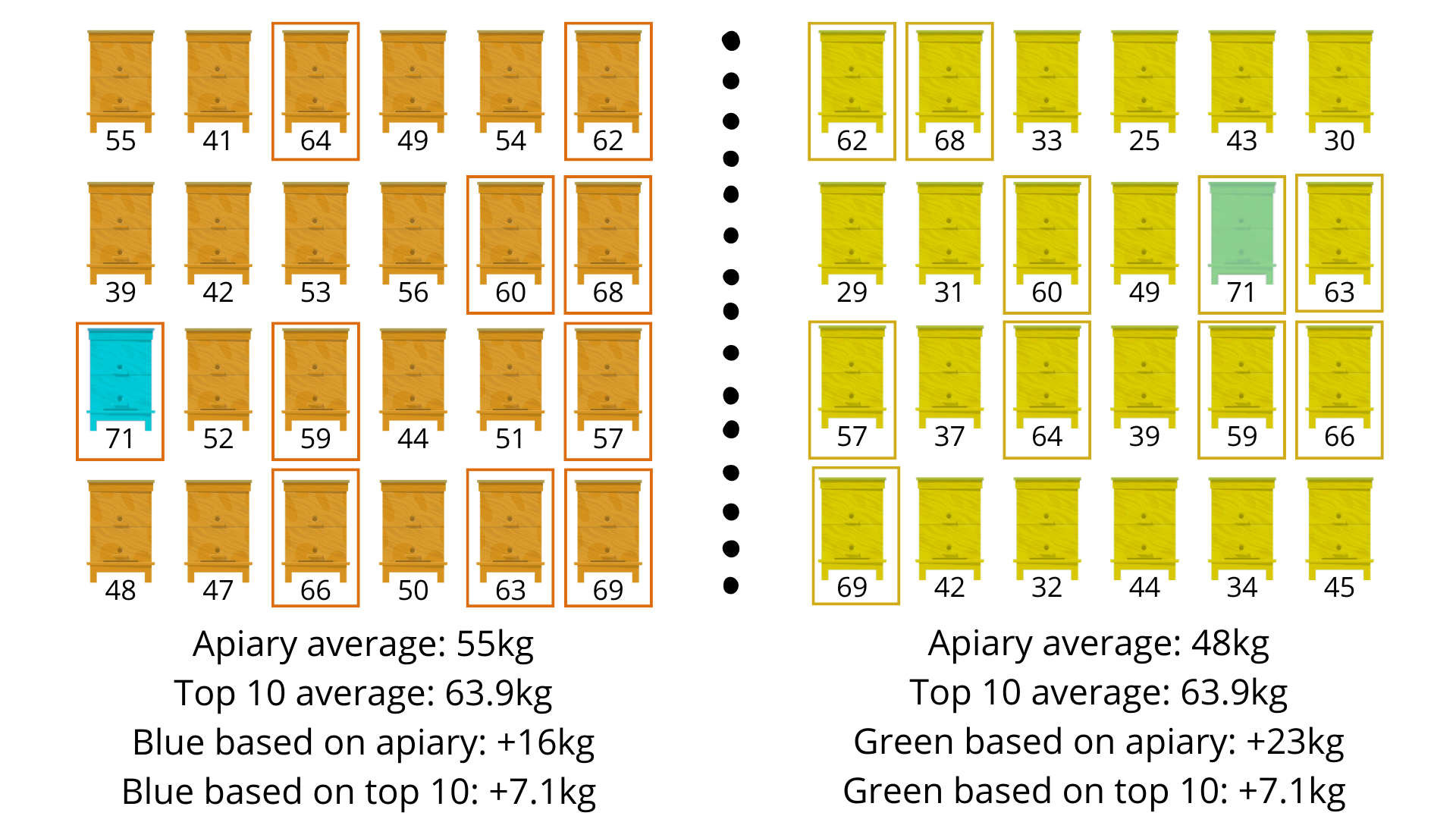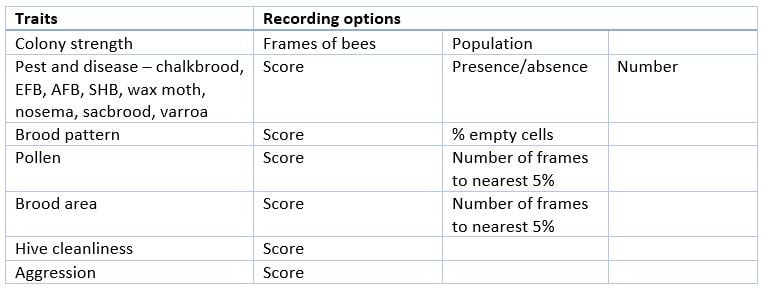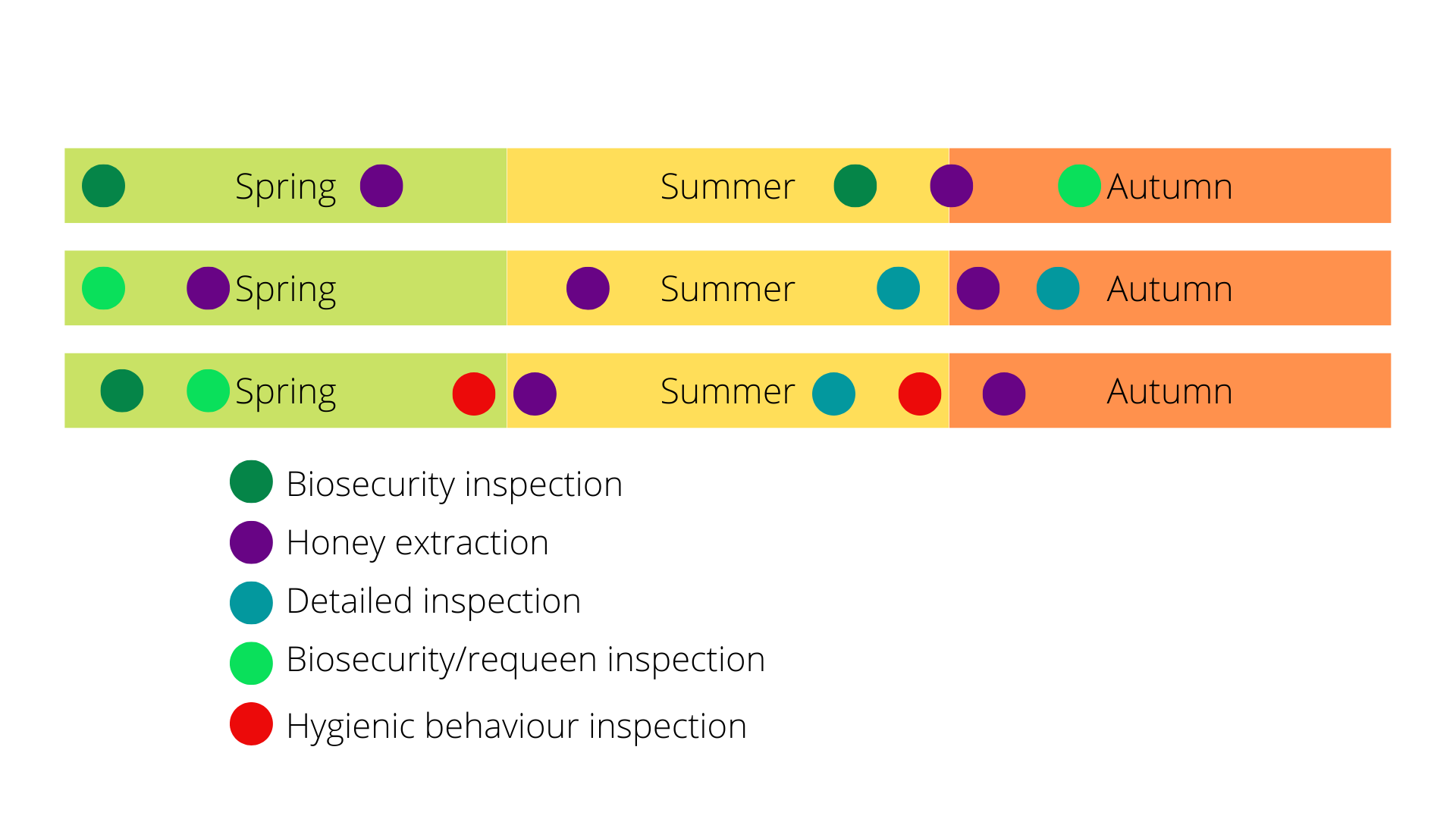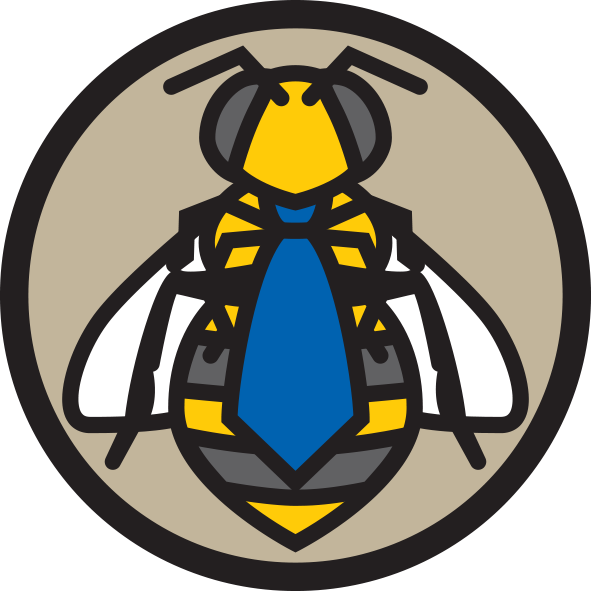Plan Bee is Australia’s honey bee genetic improvement program.
Participating bee breeders will perform colony evaluations and submit the data to the database. Once there is enough data in the database for a trait we will be able to calculate Estimated Breeding Values (EBVs). EBVs give the genetic merit of the queen compared to the population.
Breeders can use EBVs to choose which queens to use to produce the next generation and to advertise their stock to their customers. Customers could then use this information to select which breeder queen they would like to buy progeny from.
How many colonies and which ones?
When recording colonies, you should aim to record all the colonies that are being managed together in a contemporary group, e.g. a load/apiary. The genetic evaluation is based around comparing colony performance against the rest of the colonies that have been managed under the same environment.
Selective recording of only good colonies means that the analysis will unfairly classify the environment and the superiority of the colonies may be under or overestimated and the breeding value will be less reliable (Figure 1).
We recommend that the contemporary group contains a minimum of 10 colonies that are measured on the same day and by the same assessor.
The smallest unit we will consider is 10 colonies. That means:
- 10 colonies in the same apiary
- On the same day
- By the same assessor
- Of course, we encourage you to do more than 10 if you can. You could also have 2 people do 10 each. 10 is just the minimum.
Knowing the pedigree is extremely helpful, please aim to start recording the Queen mother ID of all your queens.

Figure 1. A beekeeper has two apiaries. The colonies in the first apiary produce an average of 55kg of honey while the second apiary produces an average of 48kg. If the beekeeper chose to only assess the top 10 colonies (outlined) in each apiary, they would find an average of 63.9kg. Doing this will bias breeding values. If we look at the top colony in each apiary – blue in the first and green in the second – they both produce 71kg. Based on only the top 10 colonies they both produced 7.1kg above their apiary average and are considered equally as good. However, when taking all the information into account we find that blue colony has produced 16kg above apiary average and green colony has produced 23kg above apiary average. There is a clear winner.
You don’t need to do all your traits at every evaluation
Some different types of suggested evaluations are as follows:
Bee Biosecurity Code of Practice inspection of minimum 3 brood frames – required twice a year a minimum of 4 months apart. This inspection should take up to 10 min per hive. Recording data during this industry required activity is an excellent opportunity to make the best of your time. Scores are based on 1 (low) to 5 (high). Suggested definitions of 1-5 scores are available for many traits in the Plan Bee Breeding Manual.

Easy add-on traits to your Biosecurity inspection are recommended. They will add little time to your inspection. Feel free to add additional traits: Aggression, brood pattern and likeability.
We are happy to help you develop a recording sheet for your traits. Alternatively, you may use apps to record data; please get in touch to see if we are able to transfer this data to the database.
Detailed inspection. These are the recommended traits. You could also add burr comb score, honey score, propolis score, runny score, colour scores, pollen in brood nest score, honey in brood nest score, swarming score, or larval feeding score easily to this inspection. Whichever traits are in your breeding objective or are important to yourself and/or your customers. This inspection is likely to take 10 or more minutes per hive.

Honey harvest inspection. If honey and wax are scored in the field at point of harvest, this could take 10 minutes or more per hive. The time required varies based on set-up (for example, loader with weighing capacity, honey trolleyed onto scale platform before loading, or automated weighing of trackable supers in the honey shed before extracting).

Hygienic behaviour inspection. Hygienic behaviour testing using the Freeze-Killed Brood method is a 2-day procedure taking 10 minutes or more per hive on both days.

Timing
Conditions vary around the country, and the nature of beekeeping makes it difficult to set timings like those used in other animal industries. We suggest that you perform the Bee Biosecurity Code of Practice inspection in spring (e.g. September) and another 4-5 months later (e.g. January) (Figure 2). Instead, you may wish to do a more detailed inspection, which includes the traits from the Biosecurity inspection. We recommend at least one more inspection per year, prior to packing your colonies down for winter.
Honey harvest inspections will be dictated by environmental conditions.
Temperament should not be recorded in adverse conditions.
Colony inspections should be performed in good weather – temperatures above 15 degrees and ideally below 30 degrees, with no rain, and low wind.

Figure 2. Examples of timing and inspection type for one season. The Bee Biosecurity Code of Practice requires two inspections per year, at least 4 months apart, recording of hive strength and disease. Recording is not done for 6 weeks after requeening.
Remember that data will not be used in the 6 weeks following a queen replacement as we must wait for the colony to reflect the queen’s genetics.
In the SmartBees program (EU) they gave queens an equal start by starting colonies with shook swarms. This is not standard practice in Australia, though you could implement it. You could also standardise the strength and food stores of your colonies when you add a new queen. Alternatively, when you are requeening your colonies we recommend doing a Biosecurity inspection so that we know the quality of the colony the queen is being placed in. If one queen is put in a weak colony suffering from a lot of disease and another is put in a strong, healthy colony then it will appear that one queen is outperforming the other, when this is really a result of environment (Figure 3).

Figure 3. Orange colony was suffering from lots of chalkbrood and had low population and honey stores compared to blue colony. The beekeeper requeened both colonies according to their schedule. Inspection after the queens had established (minimum 6 weeks) revealed that honey score was equal, neither colony had chalkbrood (score 1), and population was equal. The beekeeper may consider the queens to be equally as good. However, taking their starting point into consideration, the queen in orange colony has performed better – the honey score has improved from 1 to 4 while cleaning up chalkbrood, while blue colony’s honey score decreased from 5 to 4.
Acknowledgements:
- Chapman & Frost (2021) Plan Bee Breeding Manual. AgriFutures Australia
- Plan Bee (National Honey Bee Genetic Improvement Program) is supported by funding from the Australian Government Department of Agriculture, Fisheries and Forestry as part of its Rural Research and Development for Profit program. The project is further supported by AgriFutures Australia, the Department of Regional NSW, University of Sydney, University of New England Animal Genetics and Breeding Unit, Better Bees WA Inc, Wheen Bee Foundation, Costa Group, Olam, Beechworth Honey, Monson’s Honey and Pollination, South Pacific Seeds, Australian Queen Bee Breeders Association, Australian Honey Bee Industry Council, and commercial beekeepers.
- This article was peer-reviewed by Jody Gerdts and Adrian Grew.

